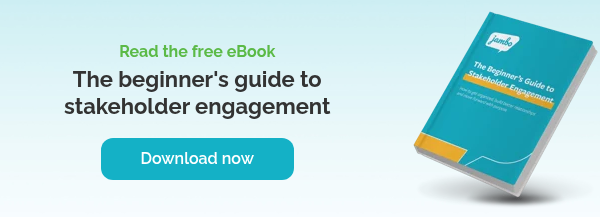
2. Communicate with stakeholders regularly
Ensure that your stakeholder engagement plan includes establishing a regular communication cadence.
This can involve setting up regular check-ins, sending newsletters or updates, or even holding planned events or webinars. You should also plan to communicate regularly with stakeholders about any new developments, changes in policies or procedures, or other vital information (before they hear it from another source).
Ensuring your messaging is clear, concise, and relevant to your stakeholders' interests and needs is essential. Messaging should also be consistent from all employees across your organization.
By communicating regularly, you can build trust and credibility with your stakeholders, demonstrate your commitment to developing a relationship with them, and achieve your goal of keeping them engaged and informed.
If you need help emailing your stakeholders, check out our free templates →
3. Track all your stakeholder information
You need a comprehensive record of all interactions between your stakeholders and your organization. It's important to track everything from your engagement history with them to their communication preferences. You can use this information to personalize communication, engage with them more effectively, and build trusting stakeholder relationships. You can better understand each stakeholder by tracking everything, including their needs, interests, and behaviour patterns.
Tracking all your stakeholders' information will help you later when fulfilling promises or commitments, or reporting on project progress to decision makers or regulatory bodies.
Whatever tool you choose for tracking your stakeholder information, ensure it's easy to use and can be integrated with your other engagement efforts. Some organizations prefer to use spreadsheets, such as Google Sheets or Excel, but these tools have several limitations. Many stakeholder engagement professionals are switching to software like Jambo, which is made specifically for managing stakeholder engagement and consultation.
4. Communicate and collaborate with your team
Stakeholder relationship management is a team effort, and it's crucial to communicate and collaborate with your team proficiently.
Collaborating with your team also means ensuring everyone involved in stakeholder engagement and maintaining stakeholder relationships is working towards the same goal. This requires clear and consistent communication of goals and objectives, as well as regular team check-ins to monitor progress and adjust strategies.
To facilitate better communication and collaboration, consider using various tools, such as specialized stakeholder engagement software, instant messaging platforms, and regular meetings. These tools can help you stay organized, share information quickly and easily, and ensure everyone is on the same page.
5. Continuously learn and adapt
Effective stakeholder relationship management requires ongoing learning and adaptation to ensure ongoing success. It's important to remember that not all stakeholder groups and communities will be the same or react similarly to your engagement plan. Review your data to show what is working and what isn't, and use it to refine your engagement strategy if needed.
In addition, it's essential to be open to feedback and suggestions from your stakeholders. This may involve conducting surveys, focus groups, or other types of research to gain a deeper understanding of their needs and preferences. You should also use this feedback to adjust your engagement strategy if needed.
Remember, changing your strategies is acceptable if they're not yielding the desired results. It's more important to demonstrate to your stakeholders that you value their input and are receptive to their feedback than to persist in communicating or engaging with them in a manner that isn't resonating well.
If you're looking for new ways to refresh your stakeholder engagement strategy, check out our blog, where we share tips on making it more meaningful →
Now that we understand the importance of stakeholder relationship management for your organization, we can proceed. By being proactive, communicating regularly with stakeholders, tracking all relevant stakeholder information, collaborating with your team, and continuously learning, you can enhance your entire stakeholder relationship management process, making it easier and more effective.
Remember, investing time and effort in building strong relationships with your stakeholders will ultimately pay dividends. For additional tips on stakeholder relationship management, check out our free guide.








